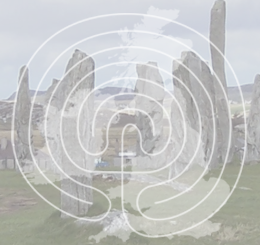St Non’s Chapel and St David’s Peninsula
St David’s Peninsula is supposedly the landing place of Twrch Trwyth, the magical boar told in the story of Culhwch and Olwen in the Mabinogion, King Arthur features heavily in the story. It is also the place where St Patrick is said to have sailed for Ireland to convert them to Christianity. He had a vision on one of the nearby peaks, which told him to return to the place of his former enslavement.
![Thruxton [CC BY 3.0 (https://creativecommons.org/licenses/by/3.0)], from Wikimedia Commons](http://www.mysteriousbritain.co.uk/wp/wp-content/uploads/2019/01/1280px-St_Nons_Chapel-300x225.jpg) The area was also the home of a small monastery built by St David, of which nothing remains. There are however traces of early Christian worship in the form of ruined St Non’s Chapel, and a holy well also dedicated to St Non. This is the place where St David is said to have been born. He was the son of St Non/Nonita and a Cardiganshire chief named Sant. The whole area is full of associations with early Christianity, and may have been used by early man as a place of worship.
The area was also the home of a small monastery built by St David, of which nothing remains. There are however traces of early Christian worship in the form of ruined St Non’s Chapel, and a holy well also dedicated to St Non. This is the place where St David is said to have been born. He was the son of St Non/Nonita and a Cardiganshire chief named Sant. The whole area is full of associations with early Christianity, and may have been used by early man as a place of worship.
On a more ghostly level the ruined Chapel is said to be haunted by ghostly singing during the time of St David’s Day on the 1st of March. Another tradition suggests that some local thieves stole one of the bells from the St David’s Cathedral, and were drowned when a violent storm blew up as they were sailing away over St Bride’s bay. The bell is still said to toll somewhere under the waters when a bad storm is on its way. Bells tolling underwater has its reflection in many British folktales.
Directions: The Pembrokeshire Coastal Path traverses the area reached from St David’s off the B4583




Re: St Non’s Chapel and St David’s Peninsula
Wirt Sykes (British Goblins, 1881) mentions that in the parish of St David’s ‘there was a flight of steps leading down to the sea, among which were a certain few which uttered a miraculous sound, like the ringing of a bell. The story goes that in ancient times a band of pirates landed there and robbed the chapel. The bell they took away to sea with them, but as it was heavy they rested it several times on their way, and ever since that day the stones it rested upon have uttered these mysterious sounds when struck.’